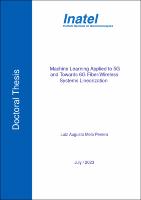| ???jsp.display-item.social.title??? |


|
Please use this identifier to cite or link to this item:
https://tede.inatel.br:8080/tede/handle/tede/250| ???metadata.dc.type???: | Tese |
| Title: | Machine Learning Applied to 5G and Towards 6G Fiber/Wireless Systems Linearization |
| ???metadata.dc.creator???: | Pereira, Luiz Augusto  |
| ???metadata.dc.contributor.advisor1???: | Júnior, Arismar Cerqueira |
| ???metadata.dc.contributor.advisor2???: | Mendes , Luciano Leonel |
| ???metadata.dc.contributor.referee1???: | Júnior , Arismar Cerqueira |
| ???metadata.dc.contributor.referee2???: | Segatto, Marcelo Eduardo |
| ???metadata.dc.contributor.referee3???: | Figueiredo, Felipe Augusto |
| ???metadata.dc.contributor.referee4???: | Ribeiro , Jose Antônio |
| ???metadata.dc.description.resumo???: | O objetivo deste trabalho e propor e avaliar o desempenho de esquemas de linearização baseados em aprendizado de máquina (ML - machine learning), aplicados a sistemas analógicos rádio sobre fibra (A-RoF - analog radio over fiber) para o transporte de sinais da quinta geração de comunicações móveis (5G - fifth generation of mobile communications) e das futuras redes de comunicações móveis de sexta geração (6G - sixth generation of mobile communications). As análises de desempenho das técnicas de linearização baseiam-se na utilização de modelos polinomiais para modelar as não-linearidades do sistema A-RoF e utilizar redes neurais para realizar a pre-e/ou pos-distorção do sinal transmitido. Considerou-se os principais componentes do sistemas A-RoF que apresentam comportamento nao-linear. Inicialmente, propõe-se um esquema de linearização para o modulador eletro-óptico de Mach-Zehnder (MZM - Mach-Zehnder modulator). Nesta abordagem, emprega-se uma rede neural perceptron com multiplas camadas (MLP - multi-layer perceptron) para realizar a pré- e/ou pós-distorção do sinal transmitido. Avalia-se também os efeitos não-lineares do amplificador de potência elétrico (PA - power amplifier), comumente utilizado em sistemas A-RoF para amplificar o sinal de radio-frequencia (RF - radio frequency) antes da radiação. Neste caso, utiliza-se a rede neural recorrente (RNN - recurrent neural network), que e capaz de lidar com o efeito memória do amplificador. A RNN possui uma estrutura de memória interna, que pode ser devidamente dimensionada para compensar as degradações não-lineares sem memória do MZM e com memória do PA. Finalmente, a dispersão cromática da fibra óptica também foi considerada, uma vez que o enlace óptico de transporte precisa ser estendido visando fornecer cobertura em áreas remotas. Para tal, utiliza-se a rede neural de atraso de tempo real aumentada (ARVTDNN - augmented real-valued time delay neural network), pois esta arquitetura permite compensar os efeitos acima mencionados. Todos os resultados destas análises foram obtidos usando simulações em Python. Este trabalho também apresenta a aplicação da técnica ARVTDNN em um sistema fibra/rádio (FiWi - fiber/wireless). Em linhas gerais, os resultados obtidos nessa tese demonstram que o uso de esquemas de linearização baseados em ML são potenciais para maximizar o desempenho de sistemas A-RoF em redes de transporte 5G e 6G. |
| Abstract: | The thesis main goals are proposing and evaluating machine learning (ML)-based linearization schemes for analog radio over fiber (A-RoF) systems from the fifth and sixth generations of mobile communications (5G and 6G). The performance analyses of the linearization techniques were based on the use of polynomial models to represent the non-linearities of the A-RoF system and artificial neural networks (ANNs) to perform pre-and/or post-distortion of the transmitted signal. The main A-RoF system non-linear components were taken into account. First, a linearization scheme was developed for the Mach-Zehnder modulator (MZM). It employs a multi-layer perceptron (MLP) ANN to perform the pre-and/or post-distortion of the transmitted signal. The electrical power amplifier (PA) non-linear effects were also evaluated. PA is commonly used in A-RoF systems to amplify the radio frequency (RF) signal before being radiated. In this case, it is required a recurrent neural network (RNN), which is able to deal with the power amplifier memory effect. RNN has an internal memory structure that can be properly designed to compensate for the non-linear degradation, considering the memoryless non-linear distortions introduced by the MZM and the memory non-linear distortion introduced by the PA. Finally, the chromatic dispersion (CD) introduced by the optical fiber was also taken into account, since the transport optical link needs to be extended to provide coverage in remote areas. The augmented real-valued time delay neural network (ARVTDNN) was used, since it allows simultaneously compensating all the aforementioned effects. All results were obtained by using Python simulations. This work also presents the application of ARVTDNN linearization scheme into a fiber/wireless (FiWi) system. Basically, the obtained results from this thesis demonstrate that ML-based linearization schemes represent potential solutions to maximize the performance of A-RoF systems from the 5G and 6G transport networks. |
| Keywords: | 5G; 6G; aprendizado de máquina; pós-distorção; pré-distorção; redes neurais artificiais e rádio sobre fibra analógico; 55G; 6G; analog radio over fiber; ANN; machine learning, post-distortion and pre-distortion; |
| ???metadata.dc.subject.cnpq???: | Engenharia - Telecomunicações |
| Language: | por |
| ???metadata.dc.publisher.country???: | Brasil |
| Publisher: | Instituto Nacional de Telecomunicações |
| ???metadata.dc.publisher.initials???: | INATEL |
| ???metadata.dc.publisher.department???: | Instituto Nacional de Telecomunicações |
| ???metadata.dc.publisher.program???: | Mestrado em Engenharia de Telecomunicações |
| Citation: | Pereira, Luiz Augusto. Machine Learning Applied to 5G and Towards 6G Fiber/Wireless Systems Linearization. 2023. [148 p.]. Tese( Mestrado em Engenharia de Telecomunicações) - Instituto Nacional de Telecomunicações, [Santa Rita do Sapucaí] . |
| ???metadata.dc.rights???: | Acesso Aberto |
| URI: | https://tede.inatel.br:8080/tede/handle/tede/250 |
| Issue Date: | 6-Jul-2023 |
| Appears in Collections: | Mestrado em Engenharia de Telecomunicações Mestrado em Engenharia de Telecomunicações |
Files in This Item:
| File | Description | Size | Format | |
|---|---|---|---|---|
| Luiz Augusto Melo Pereira (1).pdf | 15.53 MB | Adobe PDF |  Download/Open Preview |
Items in DSpace are protected by copyright, with all rights reserved, unless otherwise indicated.




